MENG 5005: Energy and Society - Nuclear Power Technology Report
VerifiedAdded on 2023/04/03
|15
|2613
|111
Report
AI Summary
This report provides a comprehensive overview of nuclear power, examining its technology, current status, and future prospects. The report begins with an abstract that highlights the role of nuclear power in low-carbon electricity production, the potential of new reactor generations, and the need for research. It then delves into the fundamentals of nuclear power, including fission and fusion processes, and the components and features of nuclear reactors. The report also presents the current status of nuclear power, including the number of operational reactors globally and their contribution to electricity generation. Furthermore, it explores the future evolution of nuclear energy, particularly Generation IV reactors, focusing on their potential to enhance sustainability, reduce waste, and improve safety. The report includes figures and tables that illustrate key concepts and data, and concludes by emphasizing the importance of addressing challenges such as nuclear waste management and fuel supply to ensure nuclear power's continued role in sustainable energy solutions. The report leverages various sources to provide a detailed analysis of the subject matter.
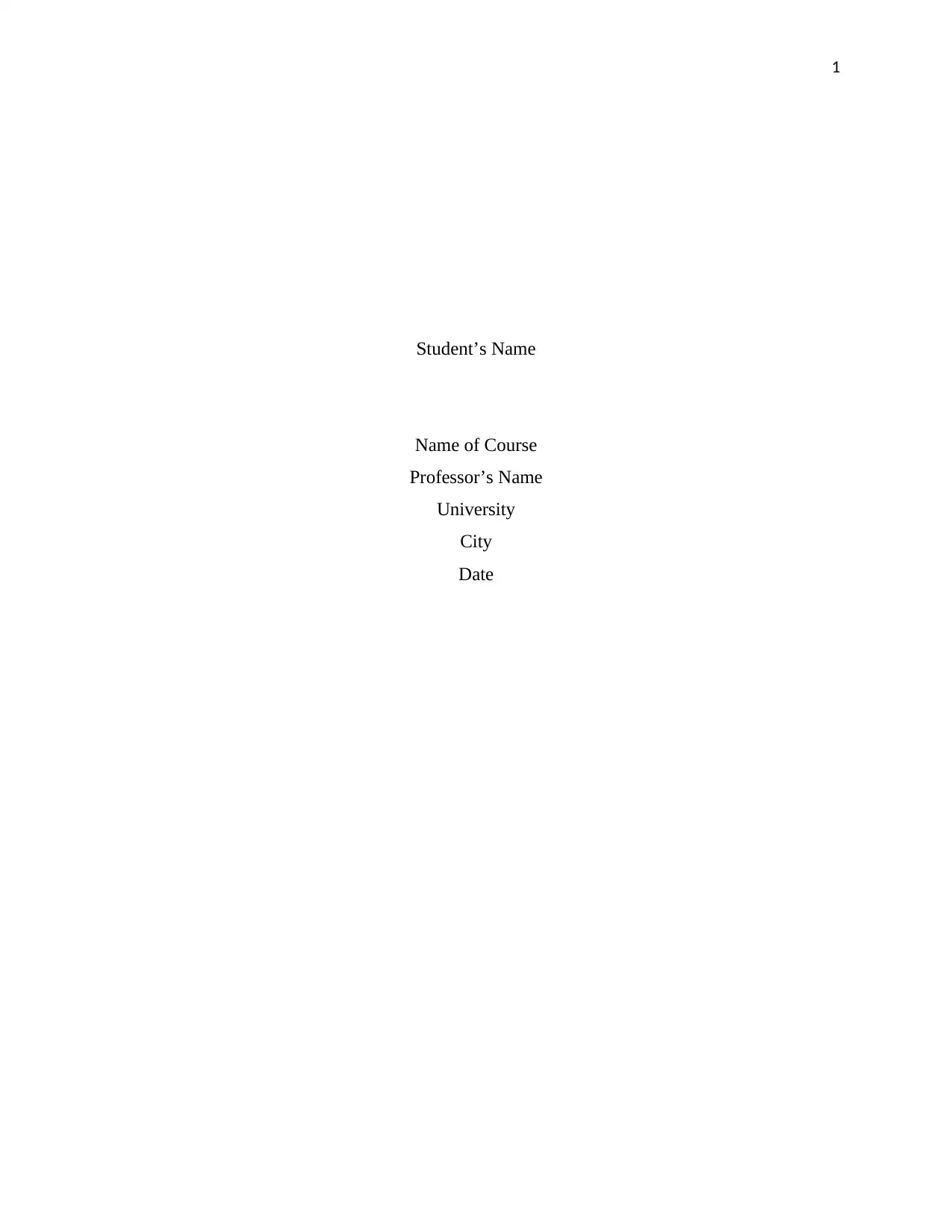
1
Student’s Name
Name of Course
Professor’s Name
University
City
Date
Student’s Name
Name of Course
Professor’s Name
University
City
Date
Paraphrase This Document
Need a fresh take? Get an instant paraphrase of this document with our AI Paraphraser
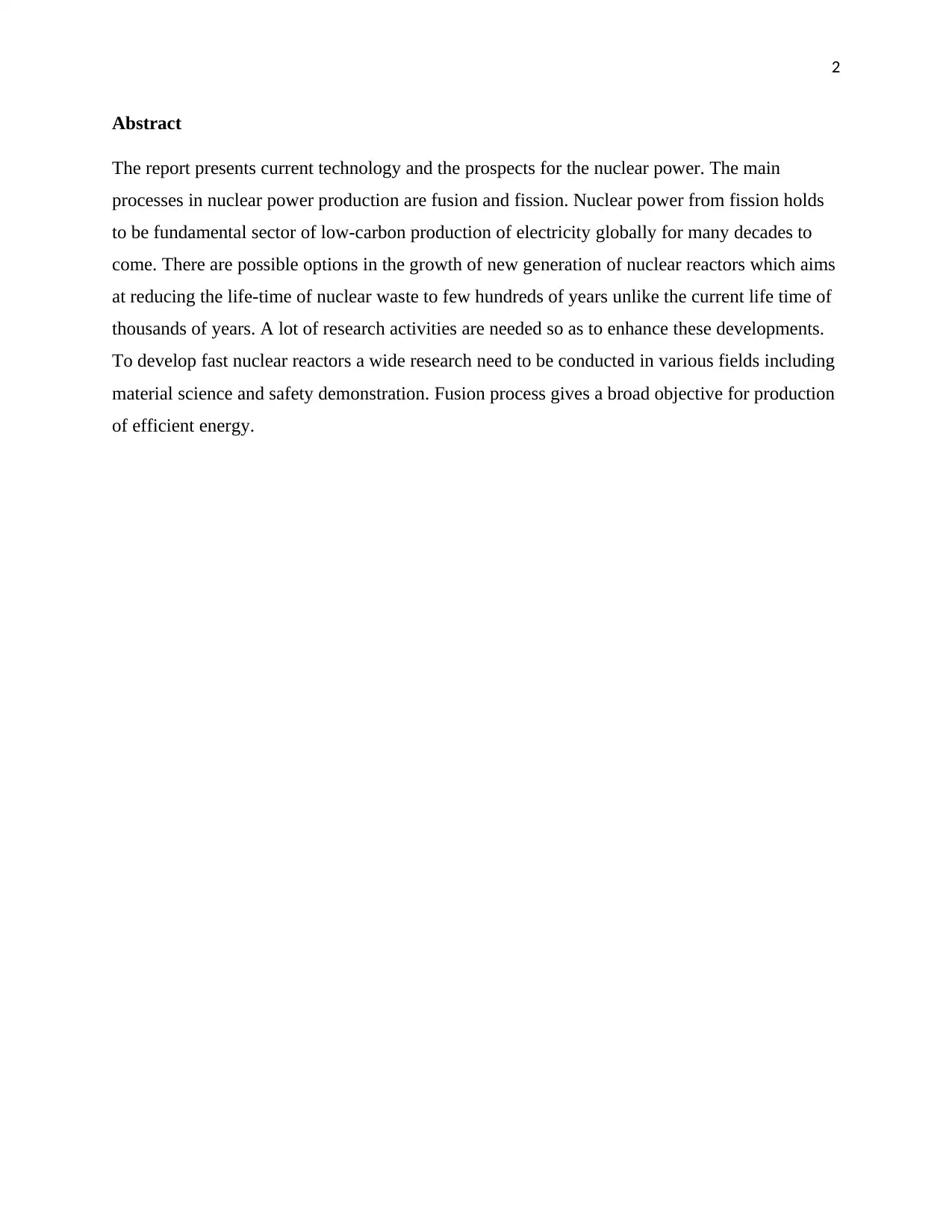
2
Abstract
The report presents current technology and the prospects for the nuclear power. The main
processes in nuclear power production are fusion and fission. Nuclear power from fission holds
to be fundamental sector of low-carbon production of electricity globally for many decades to
come. There are possible options in the growth of new generation of nuclear reactors which aims
at reducing the life-time of nuclear waste to few hundreds of years unlike the current life time of
thousands of years. A lot of research activities are needed so as to enhance these developments.
To develop fast nuclear reactors a wide research need to be conducted in various fields including
material science and safety demonstration. Fusion process gives a broad objective for production
of efficient energy.
Abstract
The report presents current technology and the prospects for the nuclear power. The main
processes in nuclear power production are fusion and fission. Nuclear power from fission holds
to be fundamental sector of low-carbon production of electricity globally for many decades to
come. There are possible options in the growth of new generation of nuclear reactors which aims
at reducing the life-time of nuclear waste to few hundreds of years unlike the current life time of
thousands of years. A lot of research activities are needed so as to enhance these developments.
To develop fast nuclear reactors a wide research need to be conducted in various fields including
material science and safety demonstration. Fusion process gives a broad objective for production
of efficient energy.

3
Acknowledgement
I would like to thank my professor and my parents who gave me the opportunity to do this great
report on energy and society, which has helped me in carrying out a lot of research and I came to
learn and understand many things concerning the technology, current status and prospects of
nuclear power.
Acknowledgement
I would like to thank my professor and my parents who gave me the opportunity to do this great
report on energy and society, which has helped me in carrying out a lot of research and I came to
learn and understand many things concerning the technology, current status and prospects of
nuclear power.
⊘ This is a preview!⊘
Do you want full access?
Subscribe today to unlock all pages.

Trusted by 1+ million students worldwide
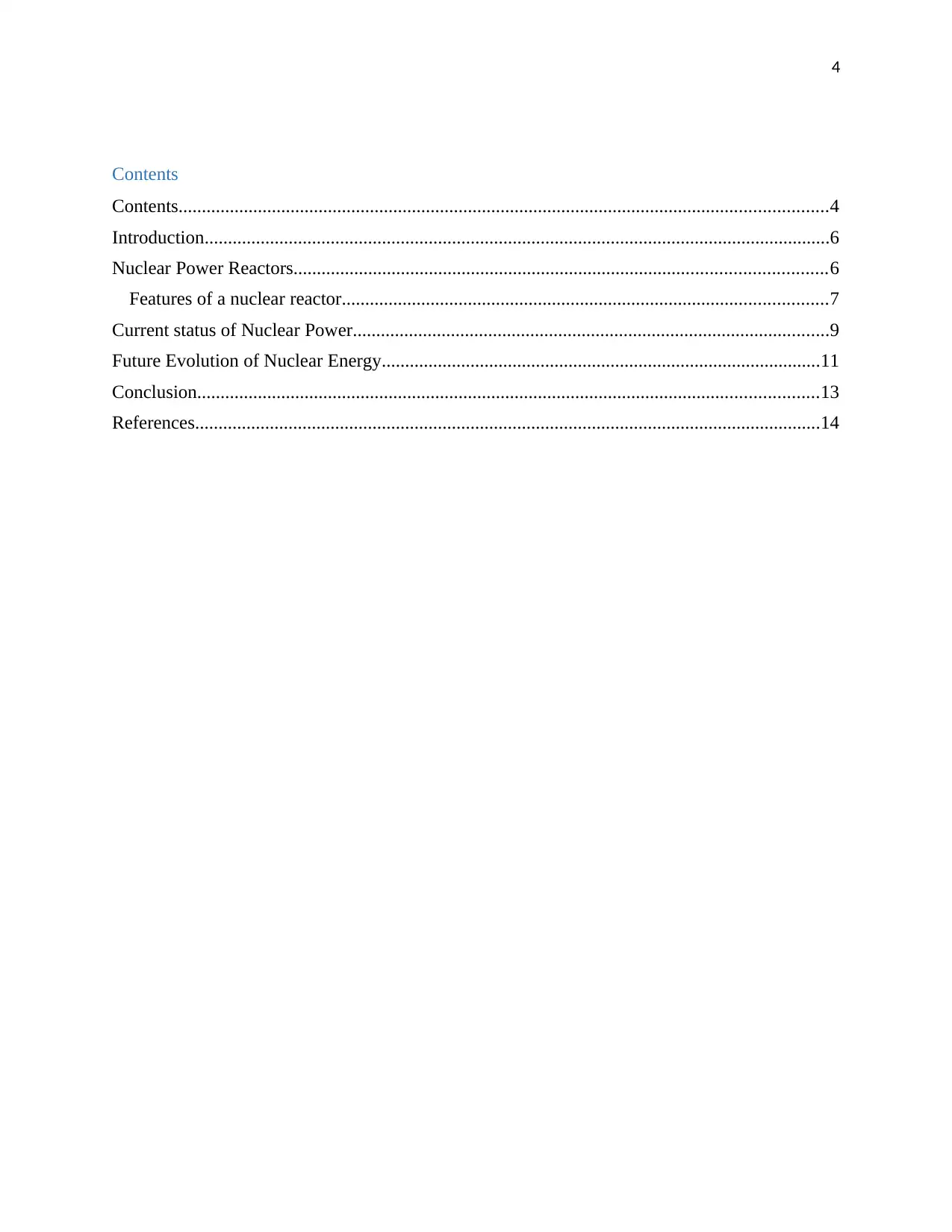
4
Contents
Contents...........................................................................................................................................4
Introduction......................................................................................................................................6
Nuclear Power Reactors..................................................................................................................6
Features of a nuclear reactor........................................................................................................7
Current status of Nuclear Power......................................................................................................9
Future Evolution of Nuclear Energy..............................................................................................11
Conclusion.....................................................................................................................................13
References......................................................................................................................................14
Contents
Contents...........................................................................................................................................4
Introduction......................................................................................................................................6
Nuclear Power Reactors..................................................................................................................6
Features of a nuclear reactor........................................................................................................7
Current status of Nuclear Power......................................................................................................9
Future Evolution of Nuclear Energy..............................................................................................11
Conclusion.....................................................................................................................................13
References......................................................................................................................................14
Paraphrase This Document
Need a fresh take? Get an instant paraphrase of this document with our AI Paraphraser
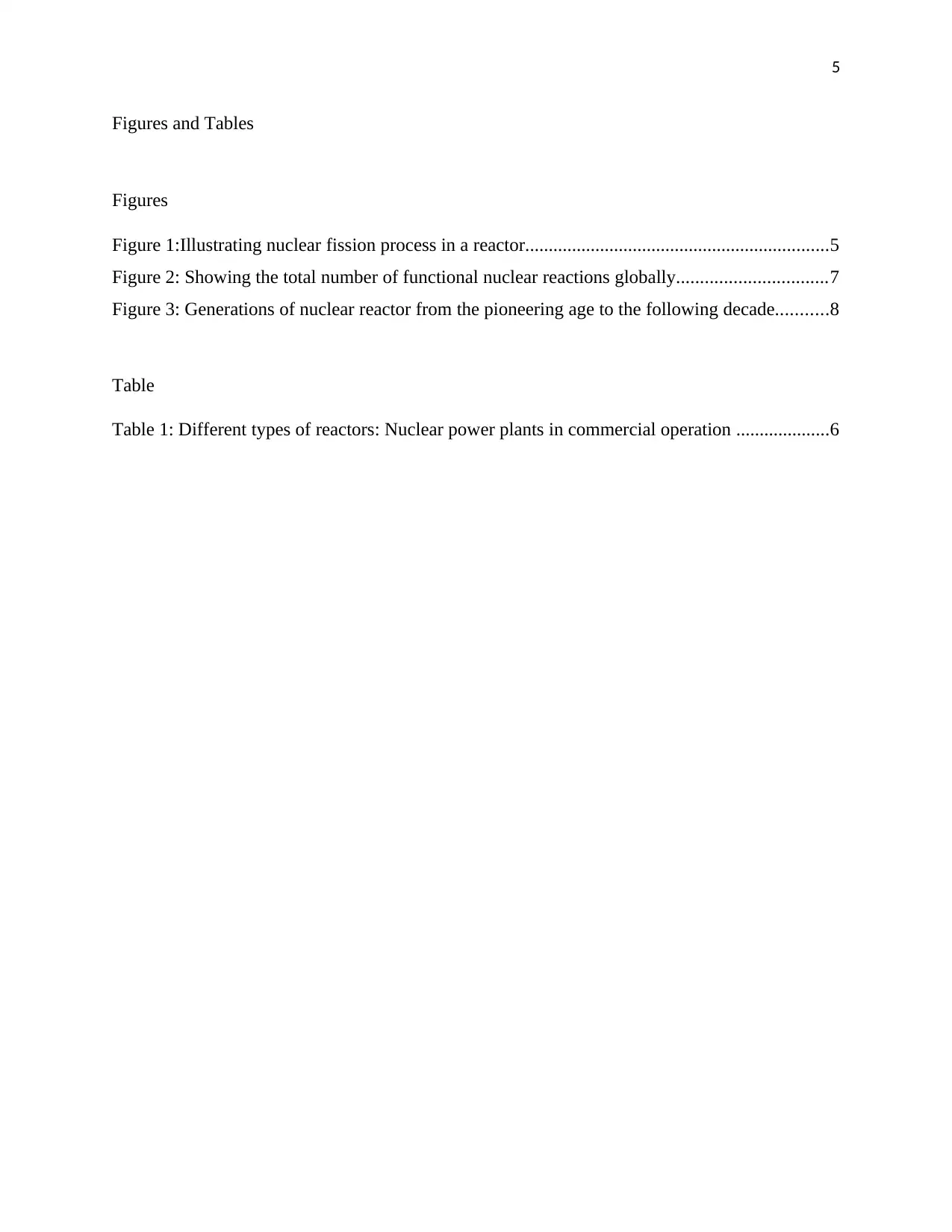
5
Figures and Tables
Figures
Figure 1:Illustrating nuclear fission process in a reactor.................................................................5
Figure 2: Showing the total number of functional nuclear reactions globally................................7
Figure 3: Generations of nuclear reactor from the pioneering age to the following decade...........8
Table
Table 1: Different types of reactors: Nuclear power plants in commercial operation ....................6
Figures and Tables
Figures
Figure 1:Illustrating nuclear fission process in a reactor.................................................................5
Figure 2: Showing the total number of functional nuclear reactions globally................................7
Figure 3: Generations of nuclear reactor from the pioneering age to the following decade...........8
Table
Table 1: Different types of reactors: Nuclear power plants in commercial operation ....................6
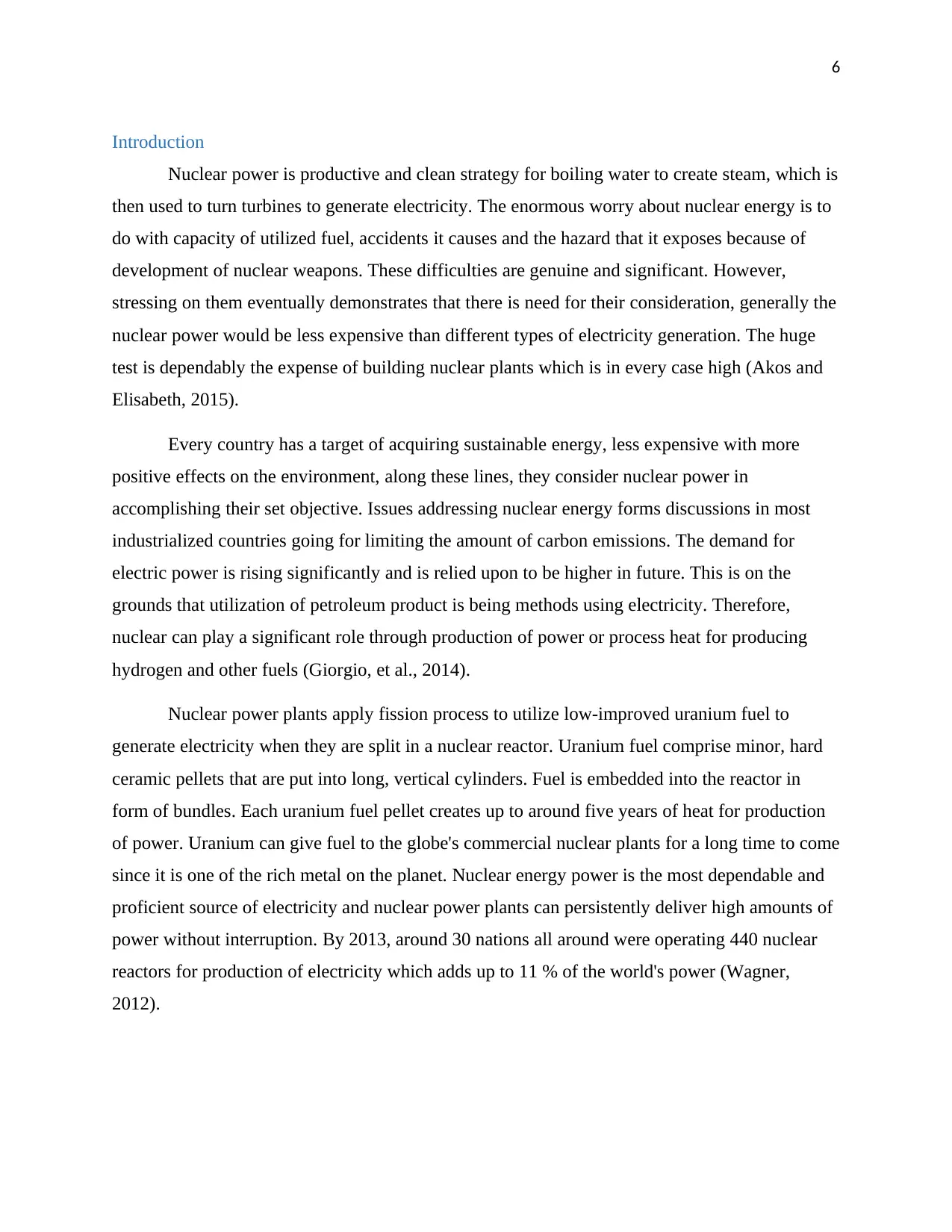
6
Introduction
Nuclear power is productive and clean strategy for boiling water to create steam, which is
then used to turn turbines to generate electricity. The enormous worry about nuclear energy is to
do with capacity of utilized fuel, accidents it causes and the hazard that it exposes because of
development of nuclear weapons. These difficulties are genuine and significant. However,
stressing on them eventually demonstrates that there is need for their consideration, generally the
nuclear power would be less expensive than different types of electricity generation. The huge
test is dependably the expense of building nuclear plants which is in every case high (Akos and
Elisabeth, 2015).
Every country has a target of acquiring sustainable energy, less expensive with more
positive effects on the environment, along these lines, they consider nuclear power in
accomplishing their set objective. Issues addressing nuclear energy forms discussions in most
industrialized countries going for limiting the amount of carbon emissions. The demand for
electric power is rising significantly and is relied upon to be higher in future. This is on the
grounds that utilization of petroleum product is being methods using electricity. Therefore,
nuclear can play a significant role through production of power or process heat for producing
hydrogen and other fuels (Giorgio, et al., 2014).
Nuclear power plants apply fission process to utilize low-improved uranium fuel to
generate electricity when they are split in a nuclear reactor. Uranium fuel comprise minor, hard
ceramic pellets that are put into long, vertical cylinders. Fuel is embedded into the reactor in
form of bundles. Each uranium fuel pellet creates up to around five years of heat for production
of power. Uranium can give fuel to the globe's commercial nuclear plants for a long time to come
since it is one of the rich metal on the planet. Nuclear energy power is the most dependable and
proficient source of electricity and nuclear power plants can persistently deliver high amounts of
power without interruption. By 2013, around 30 nations all around were operating 440 nuclear
reactors for production of electricity which adds up to 11 % of the world's power (Wagner,
2012).
Introduction
Nuclear power is productive and clean strategy for boiling water to create steam, which is
then used to turn turbines to generate electricity. The enormous worry about nuclear energy is to
do with capacity of utilized fuel, accidents it causes and the hazard that it exposes because of
development of nuclear weapons. These difficulties are genuine and significant. However,
stressing on them eventually demonstrates that there is need for their consideration, generally the
nuclear power would be less expensive than different types of electricity generation. The huge
test is dependably the expense of building nuclear plants which is in every case high (Akos and
Elisabeth, 2015).
Every country has a target of acquiring sustainable energy, less expensive with more
positive effects on the environment, along these lines, they consider nuclear power in
accomplishing their set objective. Issues addressing nuclear energy forms discussions in most
industrialized countries going for limiting the amount of carbon emissions. The demand for
electric power is rising significantly and is relied upon to be higher in future. This is on the
grounds that utilization of petroleum product is being methods using electricity. Therefore,
nuclear can play a significant role through production of power or process heat for producing
hydrogen and other fuels (Giorgio, et al., 2014).
Nuclear power plants apply fission process to utilize low-improved uranium fuel to
generate electricity when they are split in a nuclear reactor. Uranium fuel comprise minor, hard
ceramic pellets that are put into long, vertical cylinders. Fuel is embedded into the reactor in
form of bundles. Each uranium fuel pellet creates up to around five years of heat for production
of power. Uranium can give fuel to the globe's commercial nuclear plants for a long time to come
since it is one of the rich metal on the planet. Nuclear energy power is the most dependable and
proficient source of electricity and nuclear power plants can persistently deliver high amounts of
power without interruption. By 2013, around 30 nations all around were operating 440 nuclear
reactors for production of electricity which adds up to 11 % of the world's power (Wagner,
2012).
⊘ This is a preview!⊘
Do you want full access?
Subscribe today to unlock all pages.

Trusted by 1+ million students worldwide
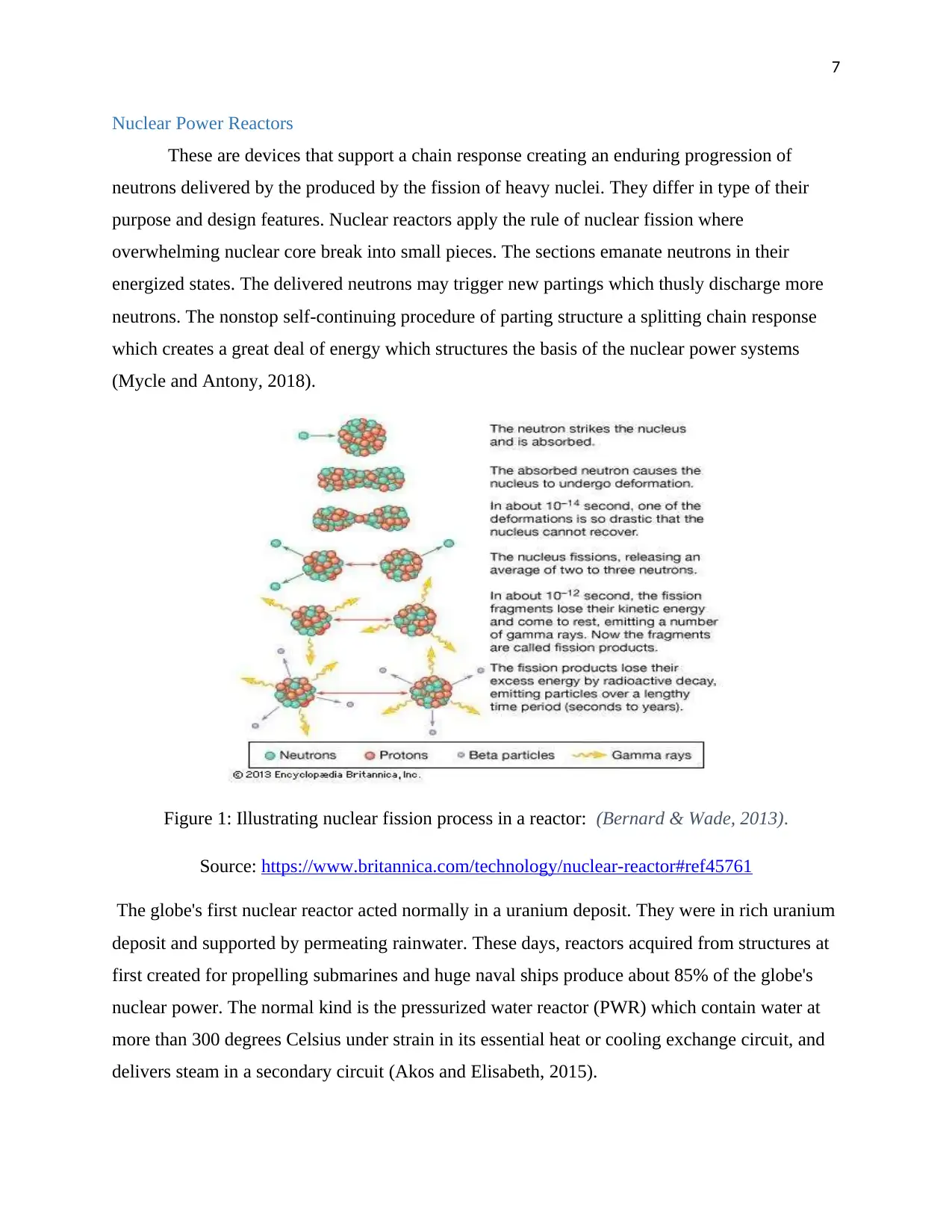
7
Nuclear Power Reactors
These are devices that support a chain response creating an enduring progression of
neutrons delivered by the produced by the fission of heavy nuclei. They differ in type of their
purpose and design features. Nuclear reactors apply the rule of nuclear fission where
overwhelming nuclear core break into small pieces. The sections emanate neutrons in their
energized states. The delivered neutrons may trigger new partings which thusly discharge more
neutrons. The nonstop self-continuing procedure of parting structure a splitting chain response
which creates a great deal of energy which structures the basis of the nuclear power systems
(Mycle and Antony, 2018).
Figure 1: Illustrating nuclear fission process in a reactor: (Bernard & Wade, 2013).
Source: https://www.britannica.com/technology/nuclear-reactor#ref45761
The globe's first nuclear reactor acted normally in a uranium deposit. They were in rich uranium
deposit and supported by permeating rainwater. These days, reactors acquired from structures at
first created for propelling submarines and huge naval ships produce about 85% of the globe's
nuclear power. The normal kind is the pressurized water reactor (PWR) which contain water at
more than 300 degrees Celsius under strain in its essential heat or cooling exchange circuit, and
delivers steam in a secondary circuit (Akos and Elisabeth, 2015).
Nuclear Power Reactors
These are devices that support a chain response creating an enduring progression of
neutrons delivered by the produced by the fission of heavy nuclei. They differ in type of their
purpose and design features. Nuclear reactors apply the rule of nuclear fission where
overwhelming nuclear core break into small pieces. The sections emanate neutrons in their
energized states. The delivered neutrons may trigger new partings which thusly discharge more
neutrons. The nonstop self-continuing procedure of parting structure a splitting chain response
which creates a great deal of energy which structures the basis of the nuclear power systems
(Mycle and Antony, 2018).
Figure 1: Illustrating nuclear fission process in a reactor: (Bernard & Wade, 2013).
Source: https://www.britannica.com/technology/nuclear-reactor#ref45761
The globe's first nuclear reactor acted normally in a uranium deposit. They were in rich uranium
deposit and supported by permeating rainwater. These days, reactors acquired from structures at
first created for propelling submarines and huge naval ships produce about 85% of the globe's
nuclear power. The normal kind is the pressurized water reactor (PWR) which contain water at
more than 300 degrees Celsius under strain in its essential heat or cooling exchange circuit, and
delivers steam in a secondary circuit (Akos and Elisabeth, 2015).
Paraphrase This Document
Need a fresh take? Get an instant paraphrase of this document with our AI Paraphraser
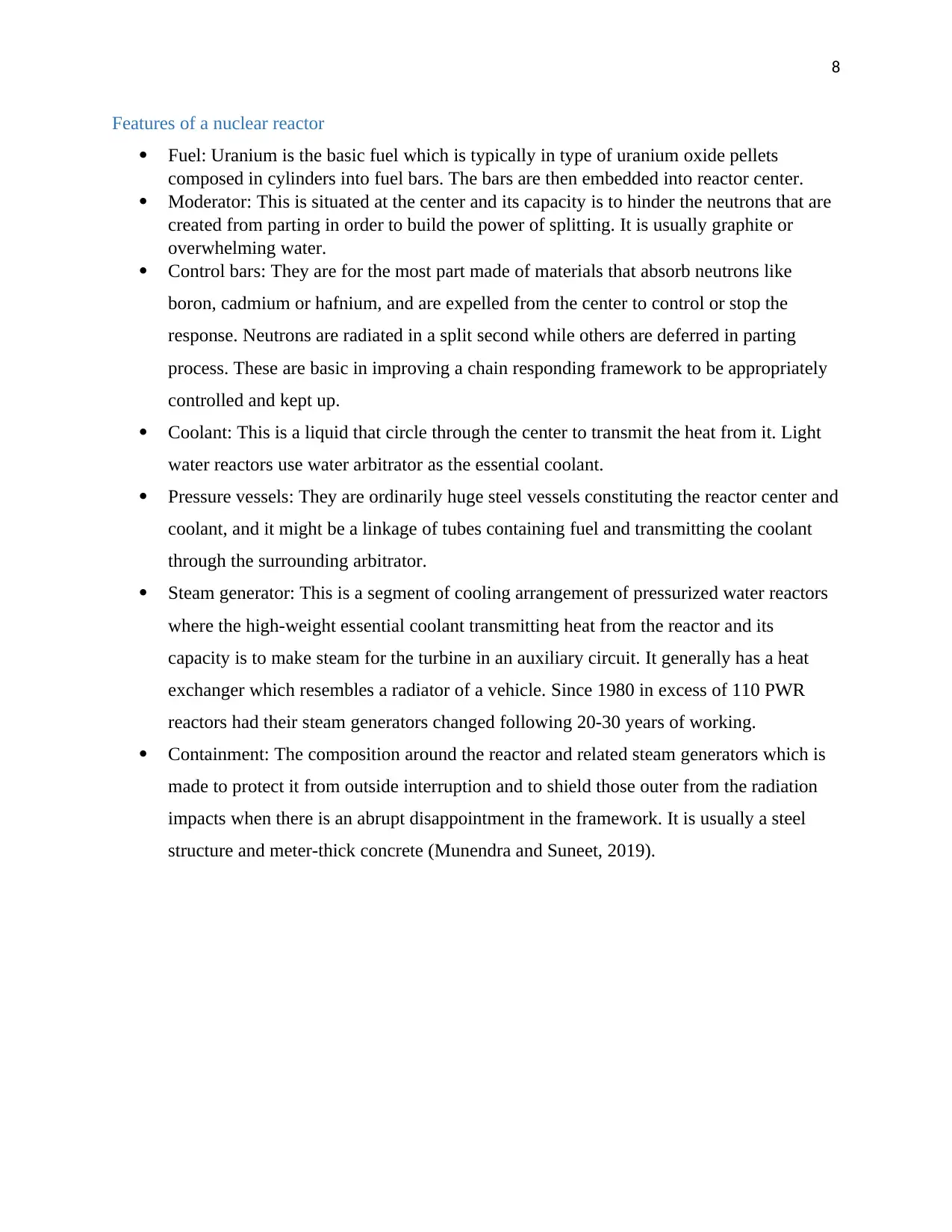
8
Features of a nuclear reactor
Fuel: Uranium is the basic fuel which is typically in type of uranium oxide pellets
composed in cylinders into fuel bars. The bars are then embedded into reactor center.
Moderator: This is situated at the center and its capacity is to hinder the neutrons that are
created from parting in order to build the power of splitting. It is usually graphite or
overwhelming water.
Control bars: They are for the most part made of materials that absorb neutrons like
boron, cadmium or hafnium, and are expelled from the center to control or stop the
response. Neutrons are radiated in a split second while others are deferred in parting
process. These are basic in improving a chain responding framework to be appropriately
controlled and kept up.
Coolant: This is a liquid that circle through the center to transmit the heat from it. Light
water reactors use water arbitrator as the essential coolant.
Pressure vessels: They are ordinarily huge steel vessels constituting the reactor center and
coolant, and it might be a linkage of tubes containing fuel and transmitting the coolant
through the surrounding arbitrator.
Steam generator: This is a segment of cooling arrangement of pressurized water reactors
where the high-weight essential coolant transmitting heat from the reactor and its
capacity is to make steam for the turbine in an auxiliary circuit. It generally has a heat
exchanger which resembles a radiator of a vehicle. Since 1980 in excess of 110 PWR
reactors had their steam generators changed following 20-30 years of working.
Containment: The composition around the reactor and related steam generators which is
made to protect it from outside interruption and to shield those outer from the radiation
impacts when there is an abrupt disappointment in the framework. It is usually a steel
structure and meter-thick concrete (Munendra and Suneet, 2019).
Features of a nuclear reactor
Fuel: Uranium is the basic fuel which is typically in type of uranium oxide pellets
composed in cylinders into fuel bars. The bars are then embedded into reactor center.
Moderator: This is situated at the center and its capacity is to hinder the neutrons that are
created from parting in order to build the power of splitting. It is usually graphite or
overwhelming water.
Control bars: They are for the most part made of materials that absorb neutrons like
boron, cadmium or hafnium, and are expelled from the center to control or stop the
response. Neutrons are radiated in a split second while others are deferred in parting
process. These are basic in improving a chain responding framework to be appropriately
controlled and kept up.
Coolant: This is a liquid that circle through the center to transmit the heat from it. Light
water reactors use water arbitrator as the essential coolant.
Pressure vessels: They are ordinarily huge steel vessels constituting the reactor center and
coolant, and it might be a linkage of tubes containing fuel and transmitting the coolant
through the surrounding arbitrator.
Steam generator: This is a segment of cooling arrangement of pressurized water reactors
where the high-weight essential coolant transmitting heat from the reactor and its
capacity is to make steam for the turbine in an auxiliary circuit. It generally has a heat
exchanger which resembles a radiator of a vehicle. Since 1980 in excess of 110 PWR
reactors had their steam generators changed following 20-30 years of working.
Containment: The composition around the reactor and related steam generators which is
made to protect it from outside interruption and to shield those outer from the radiation
impacts when there is an abrupt disappointment in the framework. It is usually a steel
structure and meter-thick concrete (Munendra and Suneet, 2019).
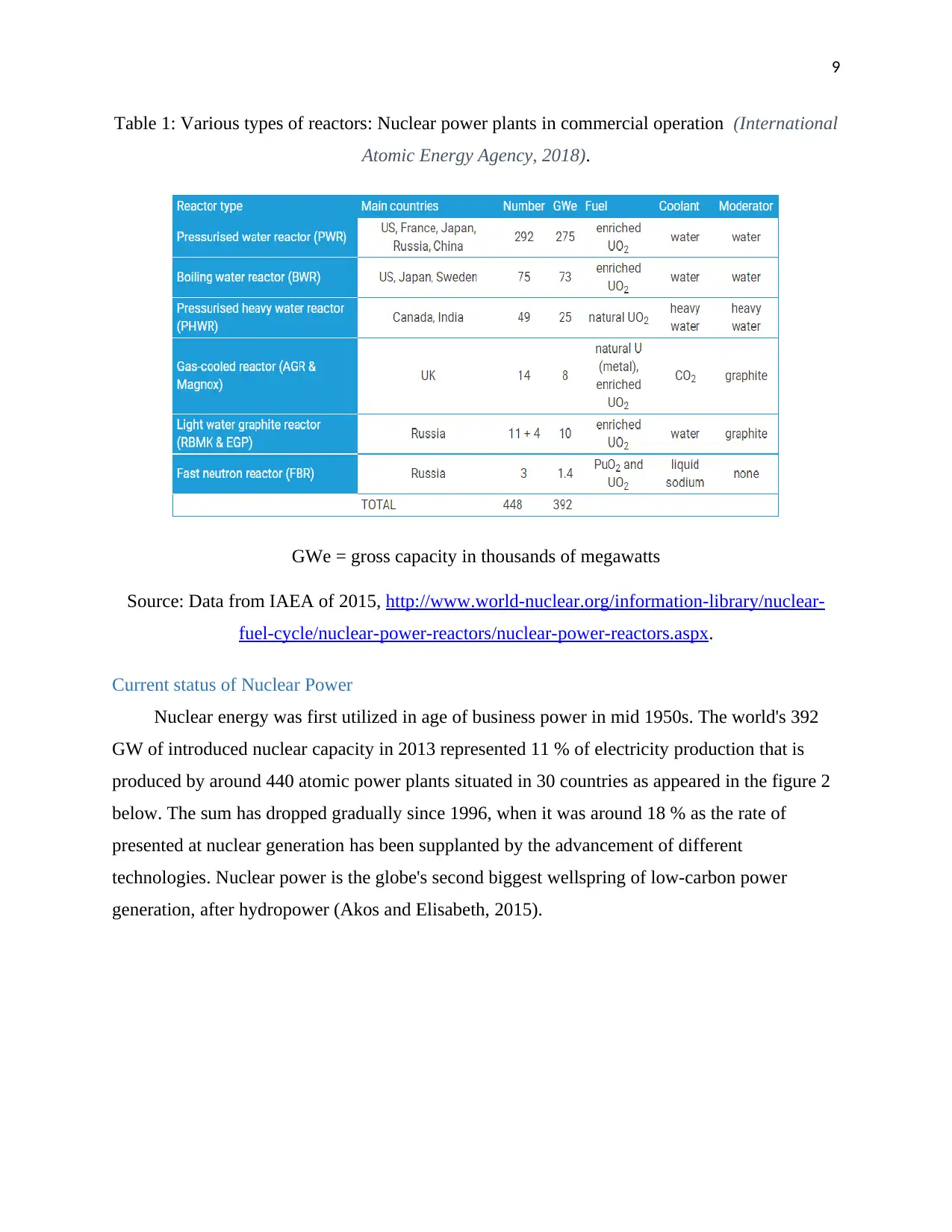
9
Table 1: Various types of reactors: Nuclear power plants in commercial operation (International
Atomic Energy Agency, 2018).
GWe = gross capacity in thousands of megawatts
Source: Data from IAEA of 2015, http://www.world-nuclear.org/information-library/nuclear-
fuel-cycle/nuclear-power-reactors/nuclear-power-reactors.aspx.
Current status of Nuclear Power
Nuclear energy was first utilized in age of business power in mid 1950s. The world's 392
GW of introduced nuclear capacity in 2013 represented 11 % of electricity production that is
produced by around 440 atomic power plants situated in 30 countries as appeared in the figure 2
below. The sum has dropped gradually since 1996, when it was around 18 % as the rate of
presented at nuclear generation has been supplanted by the advancement of different
technologies. Nuclear power is the globe's second biggest wellspring of low-carbon power
generation, after hydropower (Akos and Elisabeth, 2015).
Table 1: Various types of reactors: Nuclear power plants in commercial operation (International
Atomic Energy Agency, 2018).
GWe = gross capacity in thousands of megawatts
Source: Data from IAEA of 2015, http://www.world-nuclear.org/information-library/nuclear-
fuel-cycle/nuclear-power-reactors/nuclear-power-reactors.aspx.
Current status of Nuclear Power
Nuclear energy was first utilized in age of business power in mid 1950s. The world's 392
GW of introduced nuclear capacity in 2013 represented 11 % of electricity production that is
produced by around 440 atomic power plants situated in 30 countries as appeared in the figure 2
below. The sum has dropped gradually since 1996, when it was around 18 % as the rate of
presented at nuclear generation has been supplanted by the advancement of different
technologies. Nuclear power is the globe's second biggest wellspring of low-carbon power
generation, after hydropower (Akos and Elisabeth, 2015).
⊘ This is a preview!⊘
Do you want full access?
Subscribe today to unlock all pages.

Trusted by 1+ million students worldwide
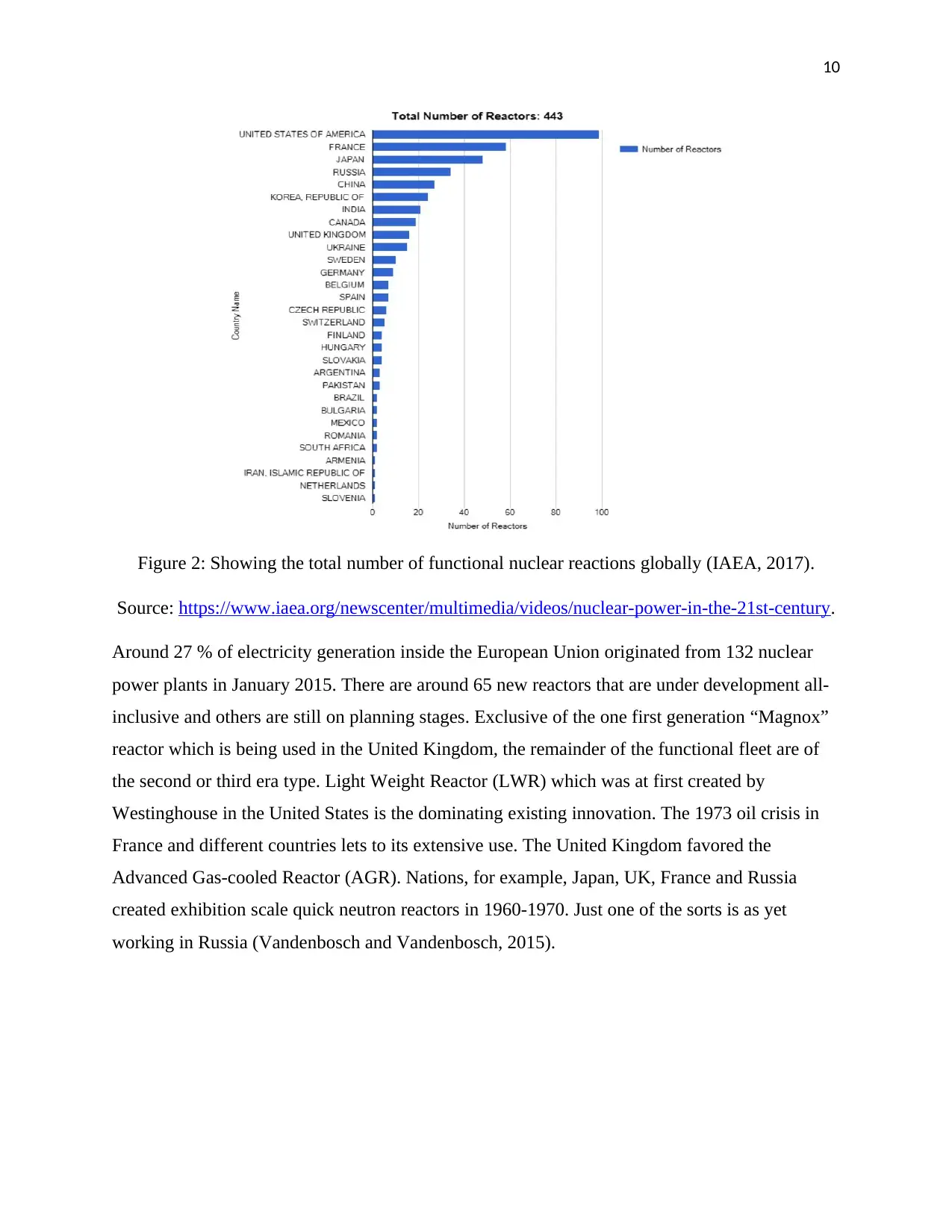
10
Figure 2: Showing the total number of functional nuclear reactions globally (IAEA, 2017).
Source: https://www.iaea.org/newscenter/multimedia/videos/nuclear-power-in-the-21st-century.
Around 27 % of electricity generation inside the European Union originated from 132 nuclear
power plants in January 2015. There are around 65 new reactors that are under development all-
inclusive and others are still on planning stages. Exclusive of the one first generation “Magnox”
reactor which is being used in the United Kingdom, the remainder of the functional fleet are of
the second or third era type. Light Weight Reactor (LWR) which was at first created by
Westinghouse in the United States is the dominating existing innovation. The 1973 oil crisis in
France and different countries lets to its extensive use. The United Kingdom favored the
Advanced Gas-cooled Reactor (AGR). Nations, for example, Japan, UK, France and Russia
created exhibition scale quick neutron reactors in 1960-1970. Just one of the sorts is as yet
working in Russia (Vandenbosch and Vandenbosch, 2015).
Figure 2: Showing the total number of functional nuclear reactions globally (IAEA, 2017).
Source: https://www.iaea.org/newscenter/multimedia/videos/nuclear-power-in-the-21st-century.
Around 27 % of electricity generation inside the European Union originated from 132 nuclear
power plants in January 2015. There are around 65 new reactors that are under development all-
inclusive and others are still on planning stages. Exclusive of the one first generation “Magnox”
reactor which is being used in the United Kingdom, the remainder of the functional fleet are of
the second or third era type. Light Weight Reactor (LWR) which was at first created by
Westinghouse in the United States is the dominating existing innovation. The 1973 oil crisis in
France and different countries lets to its extensive use. The United Kingdom favored the
Advanced Gas-cooled Reactor (AGR). Nations, for example, Japan, UK, France and Russia
created exhibition scale quick neutron reactors in 1960-1970. Just one of the sorts is as yet
working in Russia (Vandenbosch and Vandenbosch, 2015).
Paraphrase This Document
Need a fresh take? Get an instant paraphrase of this document with our AI Paraphraser
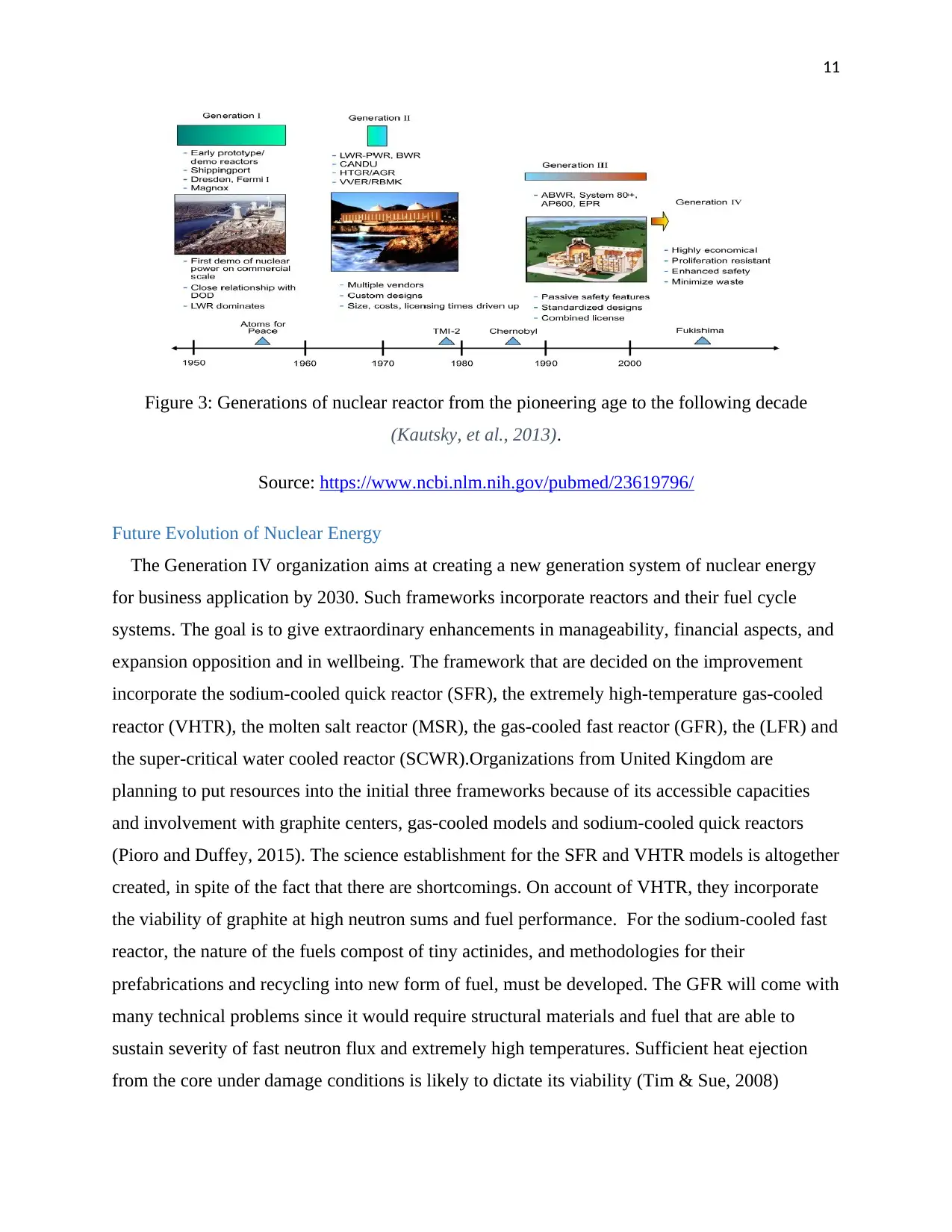
11
Figure 3: Generations of nuclear reactor from the pioneering age to the following decade
(Kautsky, et al., 2013).
Source: https://www.ncbi.nlm.nih.gov/pubmed/23619796/
Future Evolution of Nuclear Energy
The Generation IV organization aims at creating a new generation system of nuclear energy
for business application by 2030. Such frameworks incorporate reactors and their fuel cycle
systems. The goal is to give extraordinary enhancements in manageability, financial aspects, and
expansion opposition and in wellbeing. The framework that are decided on the improvement
incorporate the sodium-cooled quick reactor (SFR), the extremely high-temperature gas-cooled
reactor (VHTR), the molten salt reactor (MSR), the gas-cooled fast reactor (GFR), the (LFR) and
the super-critical water cooled reactor (SCWR).Organizations from United Kingdom are
planning to put resources into the initial three frameworks because of its accessible capacities
and involvement with graphite centers, gas-cooled models and sodium-cooled quick reactors
(Pioro and Duffey, 2015). The science establishment for the SFR and VHTR models is altogether
created, in spite of the fact that there are shortcomings. On account of VHTR, they incorporate
the viability of graphite at high neutron sums and fuel performance. For the sodium-cooled fast
reactor, the nature of the fuels compost of tiny actinides, and methodologies for their
prefabrications and recycling into new form of fuel, must be developed. The GFR will come with
many technical problems since it would require structural materials and fuel that are able to
sustain severity of fast neutron flux and extremely high temperatures. Sufficient heat ejection
from the core under damage conditions is likely to dictate its viability (Tim & Sue, 2008)
Figure 3: Generations of nuclear reactor from the pioneering age to the following decade
(Kautsky, et al., 2013).
Source: https://www.ncbi.nlm.nih.gov/pubmed/23619796/
Future Evolution of Nuclear Energy
The Generation IV organization aims at creating a new generation system of nuclear energy
for business application by 2030. Such frameworks incorporate reactors and their fuel cycle
systems. The goal is to give extraordinary enhancements in manageability, financial aspects, and
expansion opposition and in wellbeing. The framework that are decided on the improvement
incorporate the sodium-cooled quick reactor (SFR), the extremely high-temperature gas-cooled
reactor (VHTR), the molten salt reactor (MSR), the gas-cooled fast reactor (GFR), the (LFR) and
the super-critical water cooled reactor (SCWR).Organizations from United Kingdom are
planning to put resources into the initial three frameworks because of its accessible capacities
and involvement with graphite centers, gas-cooled models and sodium-cooled quick reactors
(Pioro and Duffey, 2015). The science establishment for the SFR and VHTR models is altogether
created, in spite of the fact that there are shortcomings. On account of VHTR, they incorporate
the viability of graphite at high neutron sums and fuel performance. For the sodium-cooled fast
reactor, the nature of the fuels compost of tiny actinides, and methodologies for their
prefabrications and recycling into new form of fuel, must be developed. The GFR will come with
many technical problems since it would require structural materials and fuel that are able to
sustain severity of fast neutron flux and extremely high temperatures. Sufficient heat ejection
from the core under damage conditions is likely to dictate its viability (Tim & Sue, 2008)
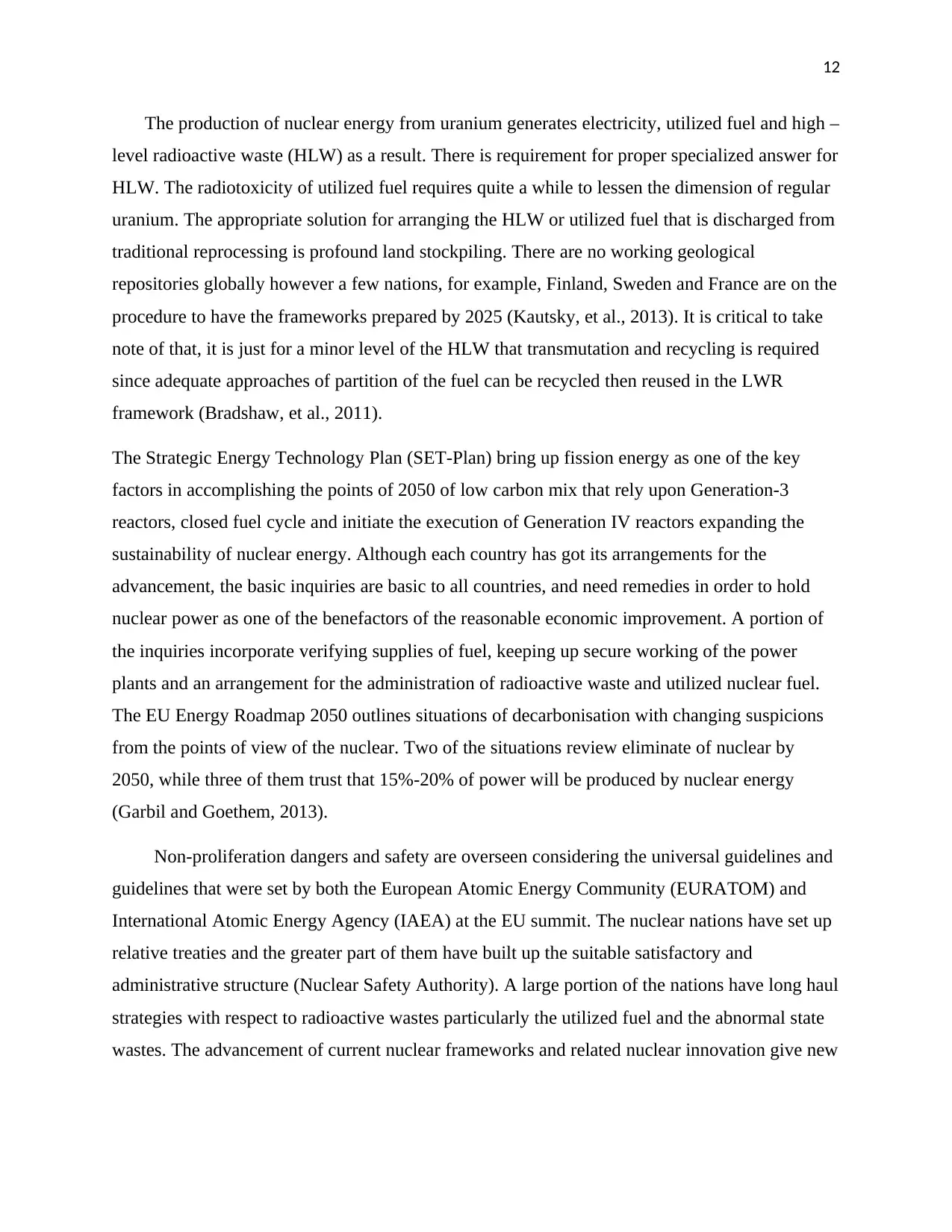
12
The production of nuclear energy from uranium generates electricity, utilized fuel and high –
level radioactive waste (HLW) as a result. There is requirement for proper specialized answer for
HLW. The radiotoxicity of utilized fuel requires quite a while to lessen the dimension of regular
uranium. The appropriate solution for arranging the HLW or utilized fuel that is discharged from
traditional reprocessing is profound land stockpiling. There are no working geological
repositories globally however a few nations, for example, Finland, Sweden and France are on the
procedure to have the frameworks prepared by 2025 (Kautsky, et al., 2013). It is critical to take
note of that, it is just for a minor level of the HLW that transmutation and recycling is required
since adequate approaches of partition of the fuel can be recycled then reused in the LWR
framework (Bradshaw, et al., 2011).
The Strategic Energy Technology Plan (SET-Plan) bring up fission energy as one of the key
factors in accomplishing the points of 2050 of low carbon mix that rely upon Generation-3
reactors, closed fuel cycle and initiate the execution of Generation IV reactors expanding the
sustainability of nuclear energy. Although each country has got its arrangements for the
advancement, the basic inquiries are basic to all countries, and need remedies in order to hold
nuclear power as one of the benefactors of the reasonable economic improvement. A portion of
the inquiries incorporate verifying supplies of fuel, keeping up secure working of the power
plants and an arrangement for the administration of radioactive waste and utilized nuclear fuel.
The EU Energy Roadmap 2050 outlines situations of decarbonisation with changing suspicions
from the points of view of the nuclear. Two of the situations review eliminate of nuclear by
2050, while three of them trust that 15%-20% of power will be produced by nuclear energy
(Garbil and Goethem, 2013).
Non-proliferation dangers and safety are overseen considering the universal guidelines and
guidelines that were set by both the European Atomic Energy Community (EURATOM) and
International Atomic Energy Agency (IAEA) at the EU summit. The nuclear nations have set up
relative treaties and the greater part of them have built up the suitable satisfactory and
administrative structure (Nuclear Safety Authority). A large portion of the nations have long haul
strategies with respect to radioactive wastes particularly the utilized fuel and the abnormal state
wastes. The advancement of current nuclear frameworks and related nuclear innovation give new
The production of nuclear energy from uranium generates electricity, utilized fuel and high –
level radioactive waste (HLW) as a result. There is requirement for proper specialized answer for
HLW. The radiotoxicity of utilized fuel requires quite a while to lessen the dimension of regular
uranium. The appropriate solution for arranging the HLW or utilized fuel that is discharged from
traditional reprocessing is profound land stockpiling. There are no working geological
repositories globally however a few nations, for example, Finland, Sweden and France are on the
procedure to have the frameworks prepared by 2025 (Kautsky, et al., 2013). It is critical to take
note of that, it is just for a minor level of the HLW that transmutation and recycling is required
since adequate approaches of partition of the fuel can be recycled then reused in the LWR
framework (Bradshaw, et al., 2011).
The Strategic Energy Technology Plan (SET-Plan) bring up fission energy as one of the key
factors in accomplishing the points of 2050 of low carbon mix that rely upon Generation-3
reactors, closed fuel cycle and initiate the execution of Generation IV reactors expanding the
sustainability of nuclear energy. Although each country has got its arrangements for the
advancement, the basic inquiries are basic to all countries, and need remedies in order to hold
nuclear power as one of the benefactors of the reasonable economic improvement. A portion of
the inquiries incorporate verifying supplies of fuel, keeping up secure working of the power
plants and an arrangement for the administration of radioactive waste and utilized nuclear fuel.
The EU Energy Roadmap 2050 outlines situations of decarbonisation with changing suspicions
from the points of view of the nuclear. Two of the situations review eliminate of nuclear by
2050, while three of them trust that 15%-20% of power will be produced by nuclear energy
(Garbil and Goethem, 2013).
Non-proliferation dangers and safety are overseen considering the universal guidelines and
guidelines that were set by both the European Atomic Energy Community (EURATOM) and
International Atomic Energy Agency (IAEA) at the EU summit. The nuclear nations have set up
relative treaties and the greater part of them have built up the suitable satisfactory and
administrative structure (Nuclear Safety Authority). A large portion of the nations have long haul
strategies with respect to radioactive wastes particularly the utilized fuel and the abnormal state
wastes. The advancement of current nuclear frameworks and related nuclear innovation give new
⊘ This is a preview!⊘
Do you want full access?
Subscribe today to unlock all pages.

Trusted by 1+ million students worldwide
1 out of 15
Related Documents
Your All-in-One AI-Powered Toolkit for Academic Success.
+13062052269
info@desklib.com
Available 24*7 on WhatsApp / Email
![[object Object]](/_next/static/media/star-bottom.7253800d.svg)
Unlock your academic potential
Copyright © 2020–2025 A2Z Services. All Rights Reserved. Developed and managed by ZUCOL.





